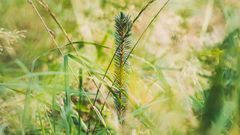13. maj 2022
Six ways you can help protect the bees
Bees are completely indispensable for the planet! And not just because they make delicious honey. Let’s take a look at what the bees do for us and how we can help them.


Do you like honey? How about bananas? Strawberries? Apples? Cherries? You can thank pollinators for all of these yummy things - and many more!
Besides bees, hummingbirds, moths, wasps, bees, butterflies and bats are also pollinators, helping our food sources reproduce and grow. Almost a third of all our food relies on pollination by these creatures, and depending where you live, between 25% and 80% of modern medicines come from forests. The bees are responsible for 80% of all pollination of plants and trees.
But unfortunately, they are in danger. Climate change, deforestation, pesticides and disease are causing us to lose more and more vital pollinators, such as bees. So what can we do to help and protect them?
Plant a bee garden
One of the biggest threats to bees is the lack of a safe place to live and find food. By planting a bee-friendly garden, you help create a safe home with plants that have plenty of pollen and nectar. You don’t need a huge garden to grow bee-friendly plants. A bee garden can be planted in planter boxes, flower pots or flower beds. You can often buy a seed mix in the supermarket that contains flowers, which attract pollinators. You can also check if there are local organisations in your area that are working to plant bee-friendly areas in public spaces.
Avoid chemicals
Pesticides, synthetic fertilisers and herbicides are harmful to bees, which are very sensitive to chemicals. Avoid using synthetic products when tending your garden. Instead, you can use organic and natural products; for example, compost is a great product to encourage your plants’ growth, and it can also help deter pests from your garden.
Create an oasis
Collecting nectar is hard work for bees. In fact, it takes a bee up to 30 hours to collect enough nectar to make a single gram of honey, so they need a well-deserved break when the work is done!
Create an oasis for bees by filling a bowl with clean water. Put pebbles in the water, breaking the surface, so the bees have somewhere to sit. You’ll then have a perfect pit stop for the bees to drink clean water.
Don’t put honey or sugar in the water! You may have heard that it’s a good snacks for the bees to recharge, but there are actually several reasons that it’s not such a good idea.
Firstly, bees will think they can collect lots of food from your oasis. So while we certainly want to help the bees, you probably don’t want hundreds of them in your garden. You also risk attracting wasps, which can be aggressive.
Plus, if bees find an easy and quick source of food (like a convenient bowl of sugar water), they’ll stop flying around visiting flowers and plants for sustenance. Without the help of bees, many plants will not be able to reproduce. So, it’s important to give bees just a refreshing bowl of water if you want to help them on their journey.
Build homes for local bees
Did you know that most bees live in solitude? The honeybee is actually one of the only bee species to live in groups. 70% of solitary bees live underground, while the other 30% live in hollow trees or branches. Bumblebees build their nests in undisturbed areas in nature, and you can help them find a safe place to live by leaving some of your garden untouched. Other bee species live in so-called “bee hotels” throughout their whole lives. You can easily build one yourself, but make sure to research which bees live in your local area. Otherwise, you risk attracting invasive species that don’t belong in the area.
Learn and tell about bees
You can help inform future generations if you yourself learn about the importance of bees and pollinators, and how we can protect them.
The more of us who talk about bees, the more of us there are to help!
Maybe you can tell your children that most of our food is grown with the help of bees. Or maybe you’ll share this article with your friends so they can help bees at home too?
Support projects that protect bees
At EcoTree, we plant bee-friendly hedges in our forests in France, where bees and other pollinators can seek shelter, collect pollen and nectar and pollinate plants in nearby forests. You can help support our projects!




